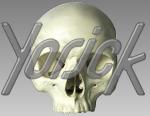
 |
 |
 |
 |
 |
 |
 |
 |
 |
3.10.1 Coordinate mapping
Since the picture you are viewing is always two dimensional, you need to project three dimensional objects onto your screen. I designed the 3D interface to allow you to change this projective mapping without re-issuing plotting commands, by analogy with the 2D limits command.
Instead of limits, however, you need to specify a projection. Imagine that your screen is the image plane of a camera. This camera carries a coordinate system in which +x is rightward, +y is upward, and +z is out of the screen toward your face. Your world coordinate system -- the coordinates of your data -- has some orientation relative to these camera coordinates. You can rotate your world coordinates -- and see the object you have plotted rotate -- using either the rot3 or orient3 commands.
The three arguments to rot3 are the angles (in radians) to rotate your object about the camera x, y, and z axes. These three rotations are applied in order, first the x angle, then the y angle, then the z angle. Omitted or nil arguments are the same as zero arguments. Note that 3D rotation is not a commutative operation, so if you want the z rotation to come first, followed by an x rotation, you need to issue two rot3 commands (like limits or logxy changes, rot3 changes accumulate so Yorick will only redraw your screen once):
rot3,,,zangle; rot3,xangle |
The orient3 operation is less general than rot3, and therefore easier to use. With orient3, the z axis of your world coordinates always projects parallel to the camera y axis, so z is plotted upward on your screen. The first argument to orient3 is the angle about the world z axis that the world x axis should be rotated relative to the camera x axis. The optional second argument to orient3 is the angle from the camera y to the world z -- the angle at which you are looking down at the scene. Once set, that downlook angle persists until you reset it. With no arguments, orient3 returns to a sane standard orientation. Hence, you can just type:
orient3 |
to return to a standard view of your scene.
Unlike rot3, the results of an orient3 are not cumulative. With each orient3 call, you completely specify the orientation of your object. Thus, if you set the orientation of your object by orient3:
orient3, -.75*pi |
and you want to twist it just a little, you would issue a slightly different orient3 command:
orient3, -.70*pi |
While if your rot3 command
rot3,, -.75*pi |
were not quite right, you'd twist it a little more by specifying a small angle:
rot3,, .05*pi |
Unfortunately, the projection operation is more complicated than merely the three angles of an arbitrary rotation matrix. The distance from your camera (or eye) to the object also enters. By default, you are infinitely far away, looking through an infinite magnification lens. This is called isometric projection, because equal length parallel segments in your world coordinates have equal length on your screen, no matter how close or far from the camera. If you want a perspective picture, you can use the setz3 command to set the z value in the camera coordinate system where your camera (or eye) is located.
Don't bother attempting to put the camera inside your data; it's not edifying. Extreme fisheye perspectives won't make your scientific data more intelligible. Keep the camera well outside your object.
Your camera always looks toward -z. Initially, the aim point is the origin of the camera coordinate system, but you can change it to any other point by means of the aim3 function. If you want to specify an aim point in your world coordinate system instead, use the mov3 function, which is analogous to rot3.
In general, you should use the nobox.gs graphics style, since the 2D axes are not useful. For an isometric view, the 2D (x,y) axes are simple projections of your (x,y,z) world coordinates. For a perspective view (after you have called setz3), the 2D (x,y) coordinates are the tangents of ray angles between the camera z axis and points on your object. The 2D limits command is useful for cropping or adjusting your view, but you should not turn off the square=1 keyword.
The functions save3 and restore3 save and later restore the entire 3D coordinate mapping, including the effects of rot3 or orient3, mov3, aim3, and setz3. You can also undo the effects of any number of these commands by means of the undo3 function.
 |
 |
 |
 |
 |
 |
 |
 |
 |